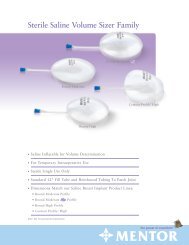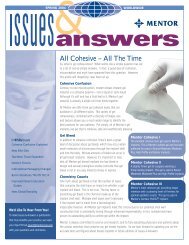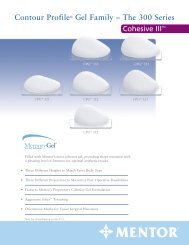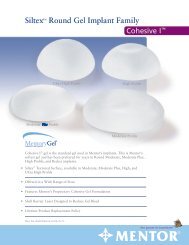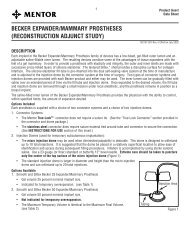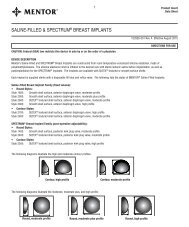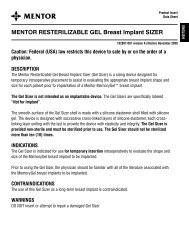Breast Reconstruction Patients Educational Brochure - Mentor
Breast Reconstruction Patients Educational Brochure - Mentor
Breast Reconstruction Patients Educational Brochure - Mentor
- No tags were found...
Create successful ePaper yourself
Turn your PDF publications into a flip-book with our unique Google optimized e-Paper software.
27Sometimes there are symptoms associated with gel implant rupture that you or your doctor cannotice. Sometimes your implants could rupture without you feeling the rupture or noticing anychanges in your breasts. In some of these instances even your doctor might not be able to tellthat a rupture has occurred. A rupture that has no symptoms is called a “silent” rupture.<strong>Mentor</strong> has done studies to better understand what causes breast implants to ruptureor leak gel. These studies might not have identified all the causes of rupture and thesestudies are continuing.When silicone gel breast implants rupture, most of the silicone gel usually stays in theimplant, and if any silicone does escape through a tear or hole, most of the gel stays withinthe scar tissue (capsule) around the implant. 1,2 Sometimes, the gel does not stay there andmay move to other areas around the body (gel migration). There have been rare reports ofgel moving to nearby tissues such as the chest wall, armpit, or upper abdominal wall, andto more distant locations down the arm or into the groin. One group of researchers foundsilicone in the livers of women with silicone gel breast implants. 3Sometimes silicone travels into the lymph nodes. When silicone gel moves into the lymphnodes, they may become enlarged. When silicone gel moves into lymph nodes or otherparts of the body, small hardened lumps of silicone (called silicone granulomas) may befelt. These lumps are NOT cancer, but it can be hard to tell them from cancerous lumpsjust by feeling them. If you feel any lumps in your breasts, around your breasts, in yourarmpits or anywhere in your body, your doctor should examine them. Based on yourpresentation and history, your surgeon may elect to observe you for a period of time orthey may begin a work up to find out why the lymph nodes are enlarged. Reasons forenlargement are varied and it may be a result of infection, silicone migration to the lymphnode, certain types of cancer, or other causes. Your doctor may have to remove a smallamount of tissue from the lump(s) (called taking a biopsy) to find out if the lump is cancer.It is important that you discuss your implant history with your surgeon as well as thedetails of your lymph node enlargement.Studies have been done to find out what, if any, effects migrated silicone gel has on thebody. 3,4,5,6,7 In most cases, no serious problems were reported. Several studies report thatsome women with migrated silicone gel experienced breast hardness, numbness and/ortingling in their extremities, and some seemed more sensitive to sunlight. 3,6,8 In a few cases,migrated gel has caused nerve damage, hard silicone nodules (granulomas) in the body,and/or breakdown of the body tissues around the gel. 7Most doctors and researchers agree that there is NO evidence that ruptured implantsor migrated gel causes any disease that affects the whole body (systemic disease) likeConnective Tissue Disease (CTD) or cancer. However, one group of researchers 4,5 reportedthat women who had migrated silicone gel had a higher risk of getting a CTD. This isdiscussed more fully in Section 4.2.Studies on breast implants that women have had for a long time suggest that gel bleedmay play a role in capsular contracture. 9• ReoperationIt is likely that you will need additional surgery (a reoperation) at some point after your firstbreast implant surgery, either to correct a problem with or replace your breast implants.<strong>Patients</strong> may decide to change the size or type of their breast implants, requiring additionalsurgery. Problems such as rupture, capsular contracture, asymmetry (lack of proportion ofshape, size and/or position between the two breasts), hypertrophic scarring (irregular, raisedscar), infection, and shifting can require additional surgery. Some changes to your breast(s)after having breast implants are irreversible (cannot be changed or fixed). These may includedimpling, puckering, wrinkling, or the appearance that the breast is empty or deflated.The MemoryShape <strong>Breast</strong> Implant Core Study reported a 36% risk of experiencingreoperation for primary reconstruction patients through 3 years after receiving implants,





